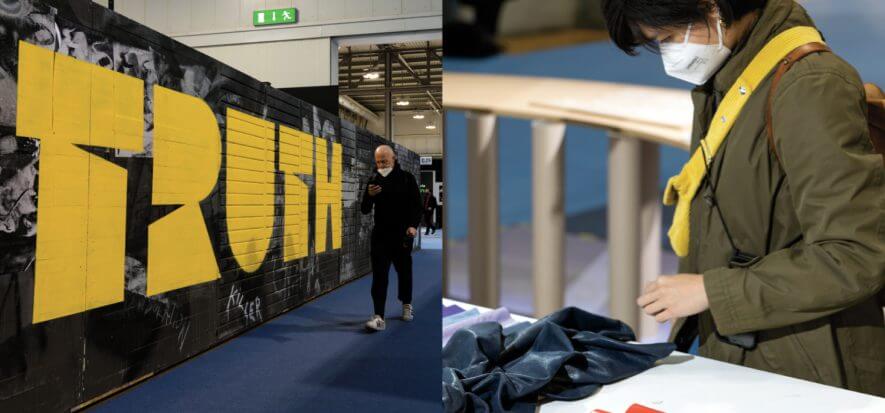How much? This is one of the most common questions asked within Lineapelle 99’s stands. How much is “everything”, because at whatever level of the chain, the stress on price lists is such that, all across, it’s all that matters at the fair even on day 1. Others, on the other hand, have made the choice to change their prices, but the big question remains: what will be the reaction of end consumers?
The chain’s equilibrium based on prices
“We are trying to balance the products offered by guaranteeing quality with price, in order to satisfy the needs of our clients – explains Gruppo Mastrotto -. We did not increase prices, but we have had to deal with the relevance tied to them. The problem is being able to precisely understand the costs we have on our end, in order to balance the prices accordingly. This equilibrium is even more important than reducing margins”.
“We are absorbing the increments in costs of materials because now it’s not the time to increase our own prices – commented Leonardo Traversi of tannery La Patrie -. We aim at increasing quantities to better absorb the costs by augmenting volume. Our profit margins suffer because we decide not to reflect the increments on our tags. We saw our energy and gas bills increase by 30% – 40% and by between 5% and 10% for chemicals. But we don’t believe raising our prices now would be the right choice”.
Making the most of the resources
“Generally speaking, we tried to absorb the increments as much as we could – added Graziano Marana of tannery Emmedue -. We did so be reorganizing labor and by focusing on conducting the most energy-intensive processes at night, when energy is cheaper. As a consequence, we have had to change work schedules, but this was also helpful because it allowed us to work when the machinery is at the right temperature, thus avoiding slowdowns. We tried to make the most out of our energy consumption. At the same time, we needed to face increases in the price of chemicals we use. In this instance we decided to substitute some, but it wasn’t always possible”.
A problem for everybody
“So – continues Marana -, we tried to define new contracts, with suppliers, that would give us more stability”. Or rather, “with fixed prices that would remain the same for a few months. The problem though, involves everyone, for example the clients we have that make outdoor shoes. Let me share an example: there has been an increase in the price of loops for laces. These components cost a few cents, but each shoe requires many. When you multiply the number for thousands of pairs, even a small increase can have a big impact”.
Reaction
Even when facing this situation, some say to just deal with it. “We are suffering costs’ increases in energy and chemicals’ prices. We are impacted without even reacting, which is why we shouldn’t be afraid or reflecting the increases in our price list – explains Giancarlo Dani, CEO of Dani tanning group -. Companies making textiles, cotton and other materials has increased prices, why shouldn’t we do the same? We sell a unique product, for which we invest money, resources and research time. Italians particularly shouldn’t be afraid, because without margins we risk closing shop. “Some have already touched up their prices. “We are seeing prices go up by between 12% and 15% – says Paolo Nardini of Primorpelli -. At the moment they have been accepted. We try to limit profits to not lose clients.
Accessories and components
“We are very impacted by the increase in energy prices – said Giulia Ravelli of Magic Sfea -. The increments of raw materials also have a large impact: plating, metals, finishings. We were forced to up our price lists in January 2022. But the increases haven’t stopped, so we don’t even know for how long we will be able to maintain our new prices. We hadn’t had in the past, but now we also have issues with sourcing the materials. Delivery times could be lengthened, and we work with medium and high-end customers that aren’t going to like the increases and delays”.
Even if “many come back to the Italian market, some buy in China because transportation costs are more manageable”. “Photovoltaic systems allow us to absorb part of the price hikes, and we also have a geothermic plant that frees us from using gas”, adds Silvia Paganini of Tacchificio Villa Cortese. “But everyone has a problem with raw materials now, given that some have gone up by as much as 80% – she concludes -. We were forced to increase the prices of our products to absorb the increases as much as possible, hoping this is a transitional period”.
Transportation delays
Then there is the matter of transportation delays, as they create further unbalance in the matter of prices. “We have had to align our prices and continue to do so, given that costs, especially for plating, changes daily – points out Antonio De Vasto of ABC Caruso Group -. Containers from China now cost immensely more than in the past: while before it was about 2,500 euro, now it can be around 12 or 13 thousand euro. While we used to pay 4,000/5,000 euro for energy, now we pay 18,000. We have to find a compromise with our clients, day after day. Luxury groups can afford increasing their high-end products, but it’s different for us”.
Read also:











